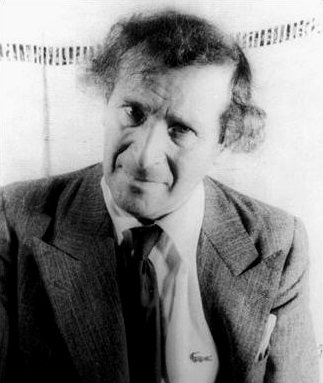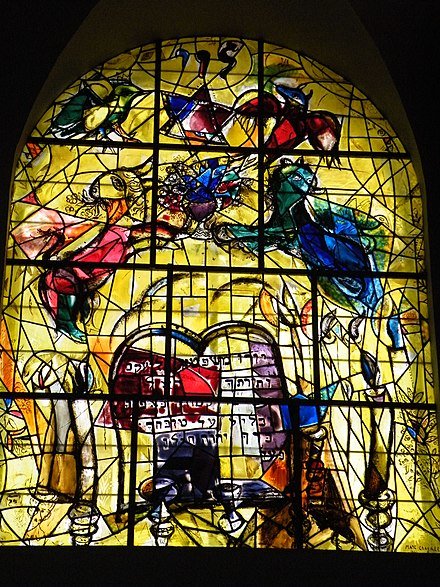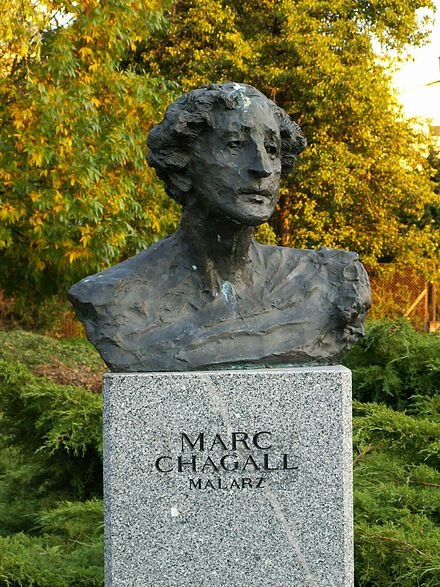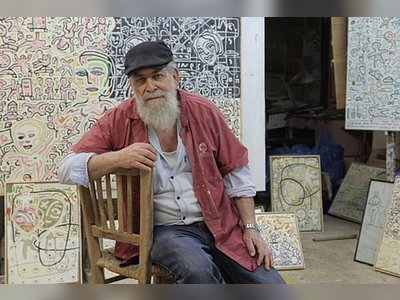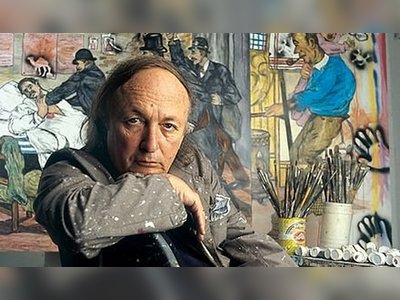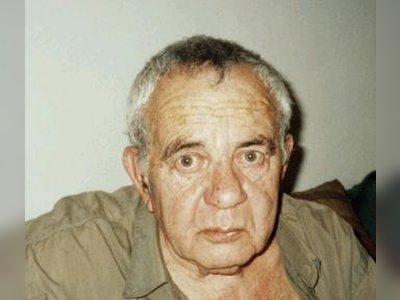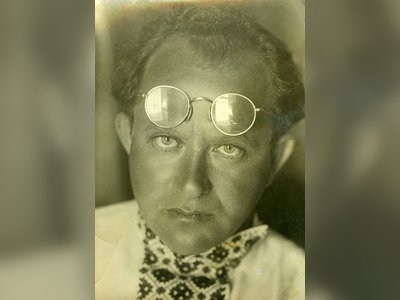מורשת גדולי האומה
בזכותם קיים
beta
Marc Chagall: A Surrealist Maestro's Journey
Marc Chagall's artistic journey was a testament to his unwavering commitment to his craft and his ability to capture the imagination of viewers through his surrealist style. His legacy lives on in the form of his masterpieces displayed in museums and institutions around the world, reminding us of the enduring power of art to transcend time and borders.
Marc Chagall, known as "Марк Шага́л" in Russian and "מַארְק שַׁאגַאל" in French, was a renowned Jewish-French-Belarusian surrealist artist who left an indelible mark on the world of art. Born on July 7, 1887, in the town of Liozna, which was then part of the Russian Empire (now in Belarus), he emerged from humble beginnings to become one of the most influential artists of his time. Chagall's artistic journey spanned several countries, with Russia and France being the most notable among them.
Born as Moishe Segal (his Ashkenazi surname would change later in life) to Khatskel and Feiga-Ita, Chagall grew up in a devout Hasidic Jewish family. He was the eldest among nine siblings. His early education took place in the confines of his home, but in 1906, he enrolled at the Academy of Fine Arts in Saint Petersburg. There, he studied under the guidance of Jewish painter Yehuda Pen. It was during this period that he began to shape his artistic identity.
In 1910, after acquiring recognition as an artist, Chagall relocated to Paris, settling in the bohemian Montparnasse district. It was here that he immersed himself in the artistic milieu, forming friendships with luminaries like Amedeo Modigliani, Fernand Léger, and others.
In 1914, Chagall briefly returned to his hometown of Vitebsk and married his fiancée, Bella Rosenfeld, whom he had met in 1909. In 1916, they welcomed their daughter, Ida. During the Russian Revolution of 1917, Chagall was appointed as the Commissar for Art in the Vitebsk region by the revolutionary government. He established an art school in Vitebsk where he taught notable artists like Kazimir Malevich and Jean Pougny.
In 1920, Chagall moved to Moscow, working in theater design and teaching at the Jewish orphanage in Malakhovka. In 1922, he relocated to Lithuania and returned to Paris in 1923 after a brief eight-month stay in Berlin, where he created a series of twenty etchings titled "My Life," reflecting his memories of Vitebsk. These etchings were showcased in several exhibitions.
The rise of the Nazis in Germany cast a shadow over Chagall's art, influencing his work to become more somber and reflective of the suffering of the Jewish people. In 1941, with the assistance of the American diplomat Varian Fry and the fourth Hiram Bingham, Chagall and his family escaped Nazi-occupied France and sought refuge in the United States. Tragically, his wife Bella passed away in 1944. Chagall remarried, and his second wife, Valentina (Vava) Brodsky, bore him a son.
In 1949, Chagall returned to France and settled in the village of Saint-Paul-de-Vence in Provence, where he lived until his death. In 1960, he was awarded the Erasmus Prize, and he dedicated the prize money to establish the "Chagall Prize," awarded annually.
On April 8, 1971, Chagall was honored with the second-highest rank in the Legion of Honour by French Prime Minister Jacques Chaban-Delmas. In 1981, he received the Wolf Prize in Arts.
Chagall visited Israel several times, with his first visit in 1931 accompanied by his wife, Bella, and his last visit in 1977 when he was awarded the title "Yakir Yerushalayim."
Marc Chagall passed away on March 28, 1985, at the age of 97, and he was laid to rest in Saint-Paul-de-Vence, Provence, France.
Marc Chagall is widely regarded as one of the greatest Jewish painters of all time. His painting style was heavily influenced by Cubism, but his works are characterized by a world of fantasy and dreams. Many of his paintings depict scenes from the Jewish shtetl life in Eastern Europe and Chasidism, as well as biblical themes. Today, most of his works are displayed in museums in the United States, Russia, Switzerland, Germany, and the Netherlands, with only a small portion residing in Israel.
Chagall's most famous work in Israel is the stained glass windows he created for the Hadassah Medical Center's synagogue in Jerusalem, depicting the twelve tribes of Israel. Additionally, he designed tapestries for the Knesset's Chagall State Hall, which depict historical events related to the Jewish people. Other notable works include murals in the Paris Opera and the Metropolitan Opera in New York, as well as stained glass windows in the cathedrals of Metz and Reims.
Early Life:
Born as Moishe Segal (his Ashkenazi surname would change later in life) to Khatskel and Feiga-Ita, Chagall grew up in a devout Hasidic Jewish family. He was the eldest among nine siblings. His early education took place in the confines of his home, but in 1906, he enrolled at the Academy of Fine Arts in Saint Petersburg. There, he studied under the guidance of Jewish painter Yehuda Pen. It was during this period that he began to shape his artistic identity.
Paris and Influences:
In 1910, after acquiring recognition as an artist, Chagall relocated to Paris, settling in the bohemian Montparnasse district. It was here that he immersed himself in the artistic milieu, forming friendships with luminaries like Amedeo Modigliani, Fernand Léger, and others.
Involvement in the Russian Revolution:
In 1914, Chagall briefly returned to his hometown of Vitebsk and married his fiancée, Bella Rosenfeld, whom he had met in 1909. In 1916, they welcomed their daughter, Ida. During the Russian Revolution of 1917, Chagall was appointed as the Commissar for Art in the Vitebsk region by the revolutionary government. He established an art school in Vitebsk where he taught notable artists like Kazimir Malevich and Jean Pougny.
Artistic Evolution:
In 1920, Chagall moved to Moscow, working in theater design and teaching at the Jewish orphanage in Malakhovka. In 1922, he relocated to Lithuania and returned to Paris in 1923 after a brief eight-month stay in Berlin, where he created a series of twenty etchings titled "My Life," reflecting his memories of Vitebsk. These etchings were showcased in several exhibitions.
Impact of Nazism:
The rise of the Nazis in Germany cast a shadow over Chagall's art, influencing his work to become more somber and reflective of the suffering of the Jewish people. In 1941, with the assistance of the American diplomat Varian Fry and the fourth Hiram Bingham, Chagall and his family escaped Nazi-occupied France and sought refuge in the United States. Tragically, his wife Bella passed away in 1944. Chagall remarried, and his second wife, Valentina (Vava) Brodsky, bore him a son.
Later Years and Legacy:
In 1949, Chagall returned to France and settled in the village of Saint-Paul-de-Vence in Provence, where he lived until his death. In 1960, he was awarded the Erasmus Prize, and he dedicated the prize money to establish the "Chagall Prize," awarded annually.
On April 8, 1971, Chagall was honored with the second-highest rank in the Legion of Honour by French Prime Minister Jacques Chaban-Delmas. In 1981, he received the Wolf Prize in Arts.
Chagall visited Israel several times, with his first visit in 1931 accompanied by his wife, Bella, and his last visit in 1977 when he was awarded the title "Yakir Yerushalayim."
Marc Chagall passed away on March 28, 1985, at the age of 97, and he was laid to rest in Saint-Paul-de-Vence, Provence, France.
Artistic Style and Masterpieces:
Marc Chagall is widely regarded as one of the greatest Jewish painters of all time. His painting style was heavily influenced by Cubism, but his works are characterized by a world of fantasy and dreams. Many of his paintings depict scenes from the Jewish shtetl life in Eastern Europe and Chasidism, as well as biblical themes. Today, most of his works are displayed in museums in the United States, Russia, Switzerland, Germany, and the Netherlands, with only a small portion residing in Israel.
Chagall's most famous work in Israel is the stained glass windows he created for the Hadassah Medical Center's synagogue in Jerusalem, depicting the twelve tribes of Israel. Additionally, he designed tapestries for the Knesset's Chagall State Hall, which depict historical events related to the Jewish people. Other notable works include murals in the Paris Opera and the Metropolitan Opera in New York, as well as stained glass windows in the cathedrals of Metz and Reims.
- מארק שאגאלhe.wikipedia.org
